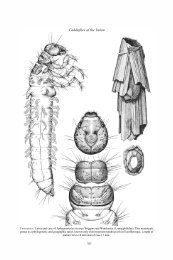Spiders of the Yukon - Department of Biological Sciences
Spiders of the Yukon - Department of Biological Sciences
Spiders of the Yukon - Department of Biological Sciences
You also want an ePaper? Increase the reach of your titles
YUMPU automatically turns print PDFs into web optimized ePapers that Google loves.
<strong>Spiders</strong> <strong>of</strong> <strong>the</strong> <strong>Yukon</strong> 109<br />
and subsequently spread westward various distances into nor<strong>the</strong>rn Eurasia and nor<strong>the</strong>rn<br />
North America. None, however, is strictly East-West Beringian today.<br />
Thirty-six species are regarded as widespread in both <strong>the</strong> Palaearctic and <strong>the</strong> Nearctic<br />
(Table 1). Examples are Arctobius agelenoides (11), Theridion petraeum (25), Microneta<br />
viaria (55), Gnaphosa orites (226), Ozyptila gertschi (253), and Neon reticulatus (290).<br />
Nine species are assigned to <strong>the</strong> range category Nearctic-West Beringian, but only 6 to<br />
<strong>the</strong> reverse category Palaearctic-East Beringian. Alopecosa pictilis (192) exemplifies <strong>the</strong><br />
former category, and Ozyptila arctica (252) <strong>the</strong> latter.<br />
Four species are assigned to <strong>the</strong> range category Cordilleran-West Beringian. Some <strong>of</strong><br />
<strong>the</strong>se range as far south as <strong>the</strong> Front Range in Colorado, and most are represented in tundra<br />
habitats, at least in <strong>the</strong> nor<strong>the</strong>rn <strong>Yukon</strong>.<br />
Twenty-six <strong>of</strong> <strong>the</strong> strictly Nearctic species are ei<strong>the</strong>r widespread Nearctic (10 species)<br />
or Cordilleran. The widespread Nearctic species extend, in some cases, into <strong>the</strong> arctic tundra,<br />
and most have outlier populations in <strong>the</strong> Cordillera and/or <strong>the</strong> Appalachians. Examples are<br />
Enoplognatha intrepida (16), Horcotes quadricristatus (105), and Pardosa albomaculata<br />
(197). The 16 species assigned to <strong>the</strong> Cordilleran range category extend from Alaska and<br />
<strong>the</strong> <strong>Yukon</strong> various distances southward into <strong>the</strong> Cordillera. None reaches <strong>the</strong> Central Plains.<br />
One species, Dictyna chitina (7), has been reported from coniferous foliage, but <strong>the</strong> o<strong>the</strong>rs<br />
are inhabitants <strong>of</strong> moss or litter. Examples are Hypomma subarctica (110), Scotinotylus<br />
majesticus (137) and Apollophanes margareta (268).<br />
Boreal Species. Approximately one-half <strong>of</strong> <strong>the</strong> species <strong>of</strong> spiders known from <strong>the</strong> <strong>Yukon</strong><br />
are judged to belong to <strong>the</strong> boreal zone (Table 1). Boreal forest covers <strong>the</strong> lowlands and river<br />
valleys <strong>of</strong> much <strong>of</strong> <strong>the</strong> land today, as it apparently did in Miocene time (Mat<strong>the</strong>ws 1979).<br />
Cooling and drying <strong>of</strong> <strong>the</strong> climate during <strong>the</strong> Pliocene, however, apparently resulted in <strong>the</strong><br />
virtual or entire elimination <strong>of</strong> such forests from Beringia, and permitted <strong>the</strong> occupation <strong>of</strong><br />
Beringia by tundra vegetation. Conditions continued to deteriorate during <strong>the</strong> Pleistocene,<br />
with sea level dropping owing to <strong>the</strong> formation <strong>of</strong> extensive glaciers elsewhere in <strong>the</strong><br />
nor<strong>the</strong>rn hemisphere. When <strong>the</strong> glaciers began to melt, toward <strong>the</strong> end <strong>of</strong> <strong>the</strong> Pleistocene,<br />
<strong>the</strong> land bridge connecting Asia and North America became severed with <strong>the</strong> opening <strong>of</strong><br />
Bering Strait. Thus boreal forest has been interrupted across <strong>the</strong> Strait possibly since late<br />
Miocene time, long enough, it would seem, to allow <strong>the</strong> boreal biota in Asia and North<br />
America to diverge significantly. Whereas this divergence appears to have taken place<br />
among plant species and in at least some groups <strong>of</strong> insects, e.g. Noctuidae (Lafontaine and<br />
Wood 1988), few <strong>of</strong> <strong>the</strong> Boreal spiders seem to exist as closely related pairs across Bering<br />
Strait. Future work using more refined techniques may reveal differences between populations<br />
in East and West Beringia that we have not yet been able to detect.<br />
Sixty-eight <strong>of</strong> <strong>the</strong> Boreal species are widespread Holarctic (Table 1). Individuals <strong>of</strong><br />
many <strong>of</strong> <strong>the</strong>se inhabit coniferous foliage, and those <strong>of</strong> many o<strong>the</strong>rs live in moss or litter in<br />
bogs and similar habitats. Most are transcontinental in North America, and many extend<br />
southward into <strong>the</strong> Cordilleran and/or Appalachian coniferous forests. Some examples <strong>of</strong><br />
<strong>the</strong>se widespread Holarctic spiders are Dictyna annulipes (5), Theridion aurantium (21),<br />
Estrandia grandaeva (39), Ceraticelus bulbosus (68), Erigone atra (88), Araneus nordmanni<br />
(168), Alopecosa aculeata (190), and Philodromus rufus (274).<br />
A second group <strong>of</strong> 13 Boreal spiders ranges widely across <strong>the</strong> Nearctic but is represented<br />
in <strong>the</strong> Palaearctic only in West Beringia. Some <strong>of</strong> <strong>the</strong>se are Theridion sexpunctatum (26),<br />
Walckenaeria castanea (155), Zygiella dispar (180) and Haplodrassus hiemalis (229).

















